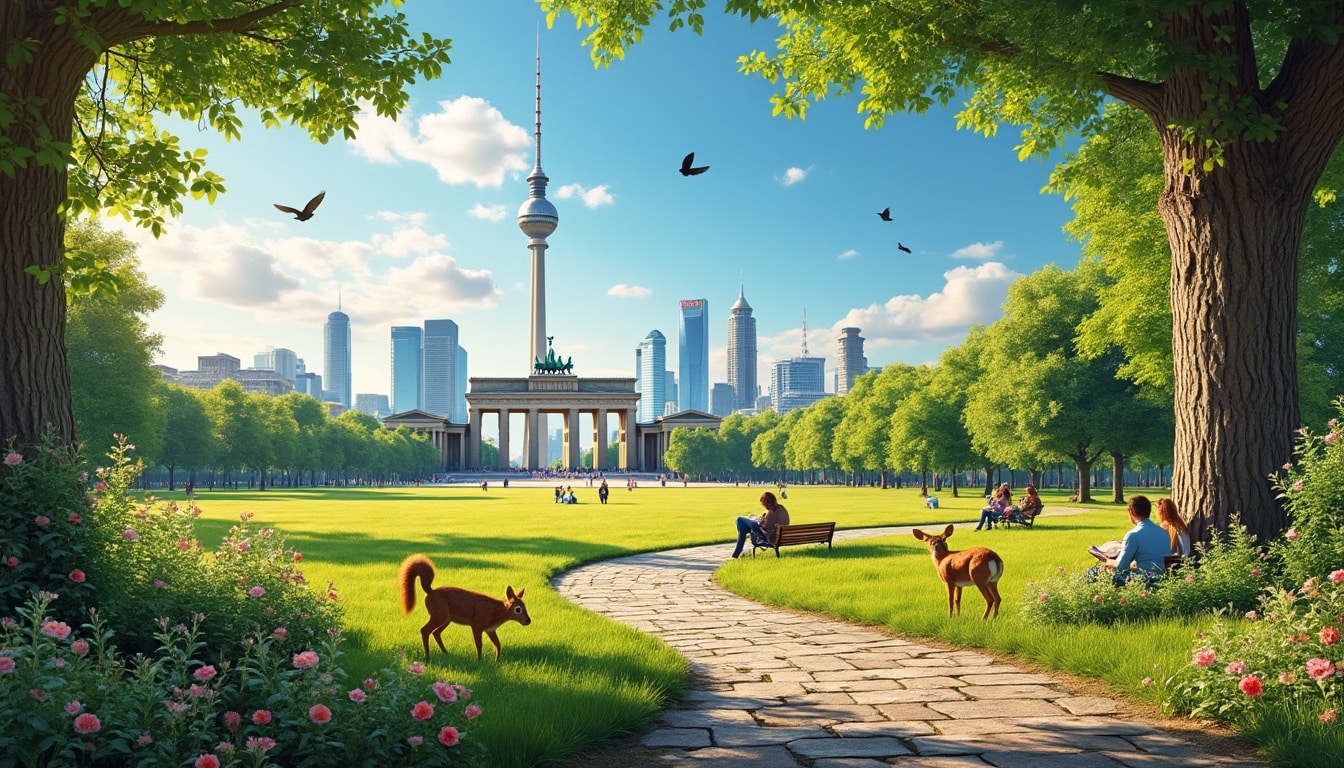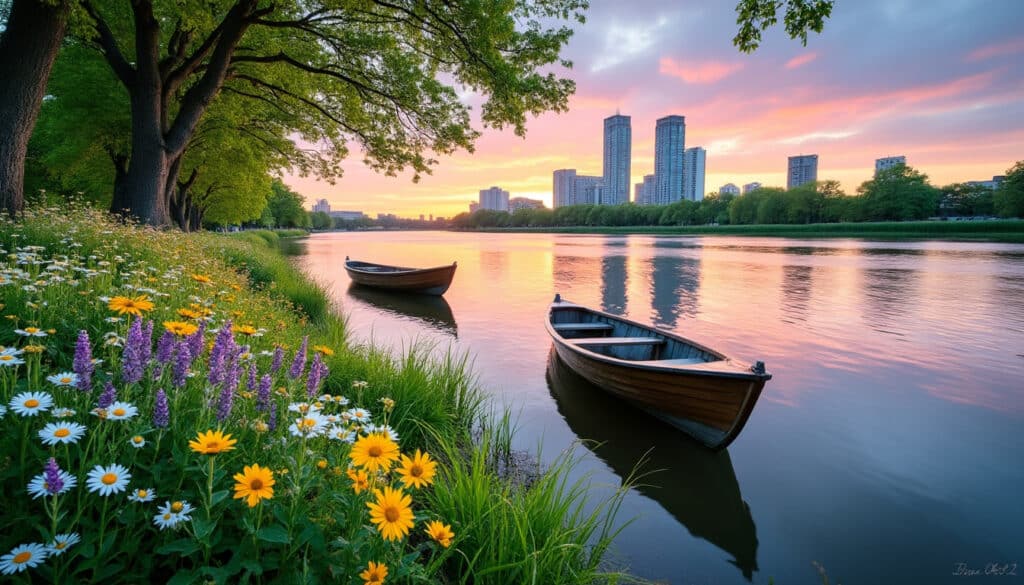Berlin, renowned for its vibrant urban life and rich history, holds a hidden treasure that few might expect from a bustling metropolis: an abundant tapestry of nature and wildlife. The city is home to a plethora of natural wonders, from expansive forests and serene lakes to diverse wildlife habitats within its metropolitan bounds. As a thriving hub for nature enthusiasts and urban explorers alike, Berlin offers an experience that merges the urban with the wild, enticing those who seek a unique balance in their travels. With its extensive parks, waterways, and preserved green spaces, the city showcases not just a commitment to green living, but also invites residents and visitors to reconnect with the natural world amidst a thriving urban environment.
Exploring Berlin’s Natural Landscapes and Wildlife
Berlin’s geographical features are a testament to its status as one of Europe’s greenest capitals, encompassing a blend of urban and natural elements that support a thriving biodiversity. Covering all corners of the city, these natural landscapes offer a fresh escape from the urban hustle, presenting a plethora of activities for nature lovers.
At the heart of Berlin’s nature offerings is the Grunewald Forest, a sprawling area that serves as a green lung for the city. The forest, the largest in Berlin, provides a habitat for a variety of wildlife, including foxes, wild boars, and an array of bird species. It’s a haven for hikers and anyone looking to immerse themselves in the tranquility of nature. A visit to Grunewald is a journey through well-marked trails, historical sites such as the Grunewald Tower, and picturesque lakes like Teufelsee, where swimming and picnicking are popular pastimes on warm days.

For those keen on exploring Berlin’s aquatic environments, the Spree River and its network of lakes offer plenty of opportunities. The river snakes through the city, linking several of Berlin’s most beautiful lakes, including Schlachtensee and Krumme Lanke. These bodies of water not only serve as recreational spots for swimming and boating but also as critical habitats for various fish and bird species, making them perfect for those interested in eco-tourism or guided Berlin Wildlife Tours.
The city’s commitment to conserving its natural spaces is evident in projects like the transformation of the Tegel airport grounds into a nature and landscape conservation area, aiming to restore the local ecology and provide a sanctuary for native species. Skylarks and heather plants have already begun to thrive, showcasing the resilience of nature when given space to flourish.
- 🌲 Grunewald Forest – Largest urban forest in Berlin
- 🏞 Teufelsee – Ideal for swimming and picnics
- 🚣♂️ Spree River – Connecting various nature spots through the city
- 🦆 Schlachtensee – Popular for birdwatching and aquatic life
- 🦢 Krumme Lanke – A picturesque swimming destination
Whether you find peace in the whispering leaves of Grunewald Forest or seek the gentle lapping of water at Berlin’s lakes, the city’s natural offerings are a vital counterpart to its urban life. For more details about Berlin’s geography and natural features, you can visit this resource.
Highlights of Berlin’s Urban Wildlife
Even amid the concrete and cobblestones, Berlin’s wildlife thrives, making the city a living example of how urban and natural environments can coexist harmoniously. Exploring the city reveals a surprising array of wildlife species that have adapted to urban living, supported by Berlin’s commitment to preserving and enhancing its green spaces.
The wild boar population in Berlin is perhaps the most famous example of urban wildlife, often spotted in the outskirts and even within city parks. While they can be somewhat intimidating, these creatures are a testament to Berlin’s successful integration of natural habitats within urban settings. Another notable species is the European hedgehog, frequently found in parks and gardens across the city.
The interaction between humans and wildlife in Berlin is facilitated by various eco-friendly initiatives and wildlife conservation projects. For instance, the city has adopted measures to protect bird populations, establishing nesting sites and safe zones to encourage breeding. Birdwatching enthusiasts can explore areas like Tiefenwerder Wiesen, known for its diverse avian population, especially in migration seasons.
Berlin’s commitment to wildlife extends beyond mere observation. Programs focused on wildlife education and conservation, such as those organized by the Berlin Zoological Garden, emphasize the importance of biodiversity and the role of urban residents in maintaining these natural ecosystems. Visitors can participate in various guided tours, which delve into Berlin’s flora and fauna, fostering a deeper connection with the city’s natural environment.
| Species | Habitat in Berlin | Population Trend |
|---|---|---|
| Wild Boar | City parks, outskirts | Stable |
| European Hedgehog | Gardens, parks | Decreasing |
| Common Buzzard | Forests, open fields | Increasing |
| House Sparrow | Urban areas | Stable |
Engaging with Berlin’s wildlife is a heartening experience, highlighting the city’s dedication to ecological balance. Those interested in the intricate details of Berlin’s fauna and urban wildlife initiatives can discover more by exploring resources dedicated to Berlin’s geographical and demographic facts at this link.
Experience the Green Side of Berlin: Parks and Gardens
Berlin’s parks and gardens are not just pockets of greenery amidst urbanity; they are vibrant ecosystems that offer solace, leisure, and a rich visual treat to their visitors. These spaces underscore what it means to integrate green living within a bustling city environment, making Berlin a paradigm of urban sustainability.
One of the most iconic landscapes is Tempelhofer Feld, a former airfield turned recreational park. Known for its expansive fields, it offers endless opportunities for leisure activities such as cycling, kite flying, and picnicking. This park stands as an emblem of Berlin’s innovative use of space, transforming the once utilitarian grounds into a public haven of community and nature intersection.
Another notable mention is the Botanical Gardens Berlin, one of the most expansive of its kind in Europe. The gardens host an impressive collection of exotic plants and themed gardens, offering a botanical journey around the world without ever leaving the city. It’s a site of immense educational value, inspiring conservation efforts and awareness about global plant species and their importance.
For those looking for a more localized green experience, the Mauerpark provides a unique combination of historical intrigue and modern-day leisure. Located at the former site of the Berlin Wall, this park has become a symbol of unity and community, where residents and visitors gather for flea markets, karaoke, and to simply enjoy the serenity offered by its verdant lawns.
- 🪁 Tempelhofer Feld – A former airfield now a communal paradise
- 🌺 Botanical Gardens – A global plant sanctuary
- 🌳 Mauerpark – Where history meets recreation
- 🌿 Tiergarten – Berlin’s heart of nature
- 🏞 Volkspark Friedrichshain – A classic city park with modern amenities
The distinct character of Berlin’s parks and gardens not only beautifies the city but also provides valuable ecological and social benefits, reinforcing Berlin as a leader in merging urban living with a sustainable lifestyle. For a deeper dive into Berlin’s approaches to nature and green spaces, additional insights can be found here.
Berlin Lakes: An Oasis in the Urban Jungle
Berlin’s lakes add a refreshing element to the city’s natural appeal, serving as key attractions for recreation and relaxation. These serene water bodies offer a welcoming break from the urban environment and are beloved by both locals and tourists who frequent them for their natural beauty and the recreational opportunities they provide.
The most celebrated of these, Wannsee, is known for its stunning landscapes and expansive sandy beach, making it a favorite choice for sunbathers and water sports enthusiasts. Wannsee is also historically significant, being the site of the famous 1920s Berlin bathing scene depicted in numerous films and literature. It remains one of the most beautiful destinations for those looking to enjoy nature by the water.
Another remarkable lake is Müggelsee, Berlin’s largest lake, which offers a variety of activities including sailing, rowing, and fishing. Its size and clean waters make it an ideal spot for families and nature lovers. The surrounding areas of Müggelsee, like the forests and parks, further enhance its appeal as a natural retreat within the city limits.
For a more exclusive escape, Liepnitzsee offers pristine waters often described as turquoise. It’s a perfect getaway for those who wish to experience a more intimate connection with Berlin’s natural landscapes, away from the usual tourist pathways. Similarly, Tegalsee, with its scenic paths and tranquil environment, is a must-visit for a serene nature connection experience.
- 🏖 Wannsee – The iconic beach with historical elegance
- 🛶 Müggelsee – Largest lake with diverse activities
- 🌊 Liepnitzsee – Berlin’s gem with turquoise waters
- 🌅 Tegalsee – A peaceful oasis for nature lovers
- 🦢 Weißensee – Close to urban life yet naturally pristine
These lakes not only cater to outdoor recreational needs but are also integral to local ecosystems, supporting a variety of aquatic life and avian species. For a comprehensive understanding of these lakes and their impact on Berlin’s ecosystem, detailed information can be accessed through various Berlin-focused geographical guides, such as the one offered here.
Encounters with Berlin’s Flora and Fauna
Exploring Berlin’s natural side wouldn’t be complete without appreciating its botanical diversity and the thriving populations of wildlife that inhabit its numerous parks and protected areas. The city’s flora and fauna have not only adapted to urban settings but have also become a vibrant part of Berlin’s identity, contributing to its unique charm.
The Berlin Botanical Gardens stand as a pinnacle of botanical research and conservation, home to a wide range of plant species that represent different climatic zones of the world. These gardens are a center of learning and exploration for visitors interested in plant ecology and conservation efforts, offering insight into the intricate ecosystems that extend beyond human cities.
Moreover, Berlin’s commitment to wildlife conservation is embodied in various initiatives aimed at preserving its natural heritage. From parks like Volkspark Humboldthain, which doubles as a wildlife sanctuary for many bird species, to conservation areas focused on specific habitats like those at Flakensee, the city ensures that its natural environments are protected and appreciated.
- 🌸 Berlin Botanical Gardens – Global plant showcase
- 🦉 Volkspark Humboldthain – A haven for birdwatchers
- 🍃 Flakensee – A scenic conservation lake
Engaging with Berlin’s natural inhabitants is an enriching experience, offering a glimpse into the thriving biodiversity sustained within the city. Whether through organized tours or independent exploration, these encounters highlight the integral role that nature plays in shaping the cultural and environmental framework of Berlin. For those eager to delve into the specifics of Berlin’s flora and fauna, comprehensive resources and guides are available from several dedicated Berlin Nature Experience platforms.
FAQs
- What is the best time to visit Berlin for nature activities?
- Are there any guided wildlife tours available in Berlin?
- Can you rent equipment for outdoor activities like biking or paddling in Berlin?
- How does Berlin support its urban wildlife populations?
- Where can I learn more about Berlin’s nature and wildlife?
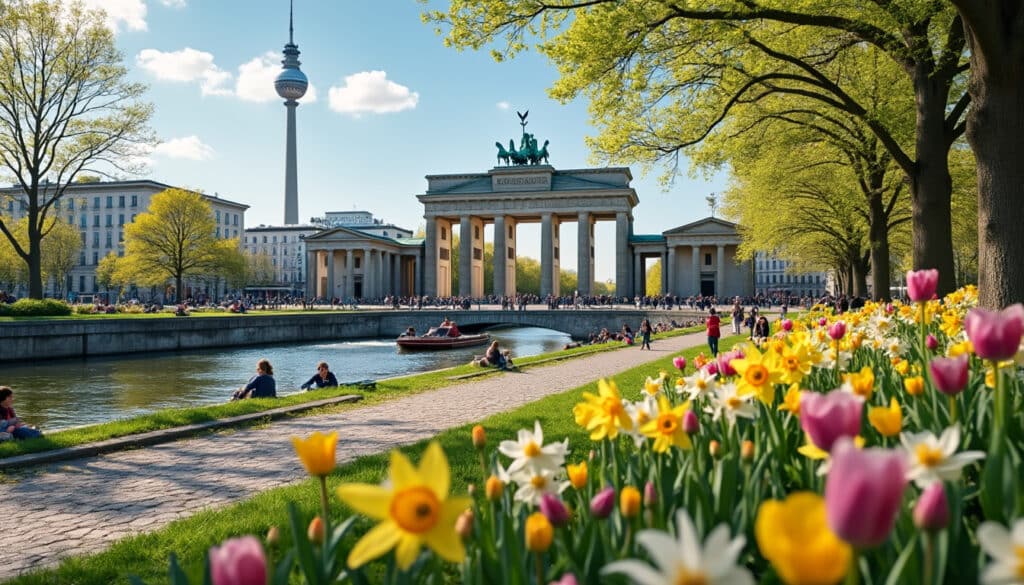
Nature and Geography of Berlin
As one of Europe’s most vibrant cities, Berlin boasts a unique blend of history, culture, and modernity. However, beyond its urban allure, Berlin offers an exceptional geographical landscape intertwined with nature. Known for its vast parks, tranquil lakes, and the…
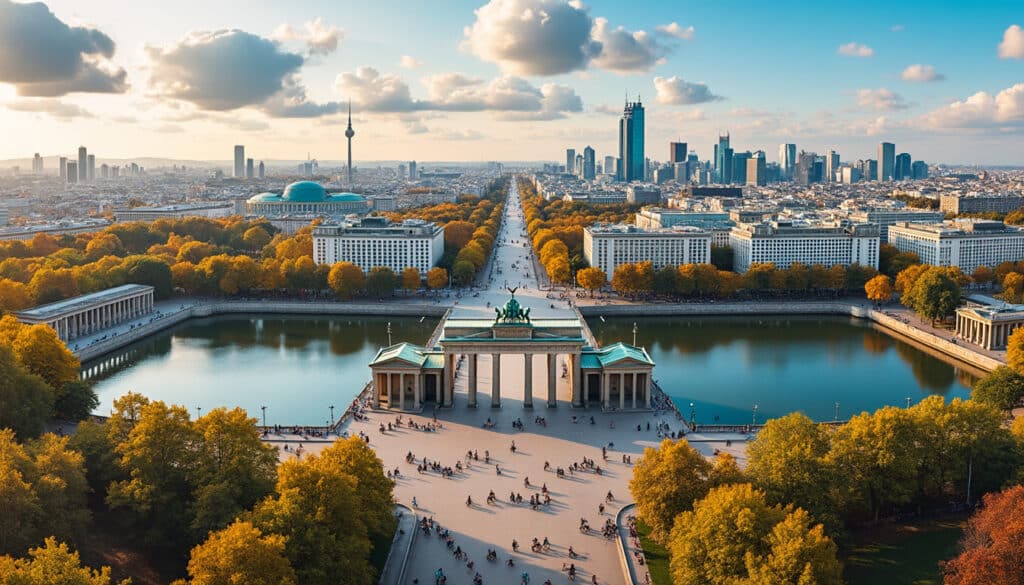
Geographical features of Berlin
Berlin, a city steeped in history and modern dynamism, stands as a masterpiece of geographical contrasts and cultural mosaics. Nestled in the northeast of Germany, the capital city is framed by the lush forests and waterways that soften its urban…
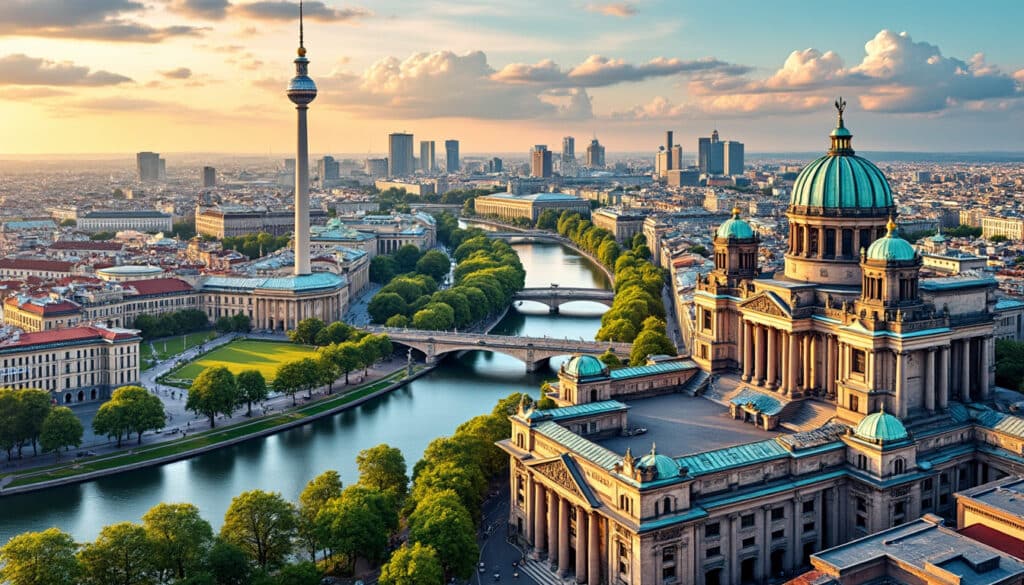
Location and coordinates of Berlin
Berlin is more than just the capital of Germany; it’s a city rich with history, culture, and an unmistakable vibe that attracts millions each year. Understanding Berlin’s location and its geographic coordinates is essential for anyone looking to truly explore…

